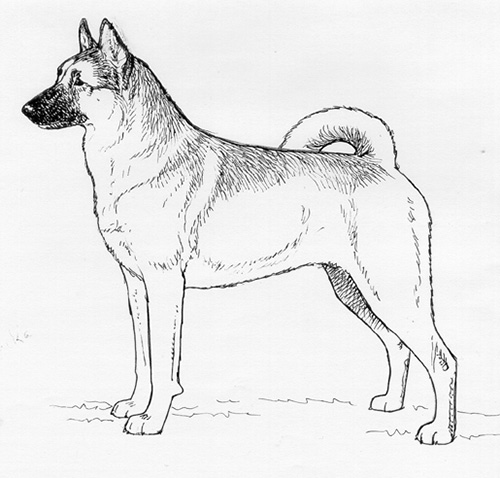East Siberian Laika
Northern Breed Group
The goals and purposes of this breed standard include: to furnish guidelines for breeders who wish to maintain the quality of their breed and to improve it; to advance this breed to a state of similarity throughout the world; and to act as a guide for judges.
Breeders and judges have the responsibility to avoid any conditions or exaggerations that are detrimental to the health, welfare, essence and soundness of this breed, and must take the responsibility to see that these are not perpetuated.
Any departure from the following should be considered a fault, and the seriousness with which the fault should be regarded should be in exact proportion to its degree and its effect upon the health and welfare of the dog and on the dog’s ability to perform its traditional work.
History
The East Siberian Laika is descended from the Spitz-like Aboriginal dogs that were most likely brought to the areas of the Baikal Lake region, Irkutsk Province, Evenki National Territory, Amur River basin and the Maritime Territory by tribes that were migrating from the west. Early Laikas in the east of Siberia were diverse in their size, head proportions, size of ears and shape and carriage of tail. Some of this diversity is still seen in the breed today. The East Siberian Laika is the largest of the Russian Laika breeds used for hunting. It is also used as an all purpose draft, sledge and drover dog.
The East Siberian Laika was recognized by the United Kennel Club January 1, 1996.
General Appearance
The East Siberian Laika is a large, strong dog, nearly square in proportion, with a typical Spitz type head and a medium length, double coat of varying colors.
Characteristics
A natural hunting dog, the East Siberian Laika has a strong instinct to hunt both large and small game. The breed is territorial and prone to be aggressive to any dog of the same sex that invades its property. They are not normally aggressive towards people, but can be good watchdogs.
Head
The head is wedge shaped.
SKULL
The skull is broad, with a well-defined occipital protuberance. The stop is gradual, not abrupt.
MUZZLE
The muzzle is nearly as long as the skull. In profile, it is wedge shaped, with tight, dry lips. The top line of the muzzle lies in a plane parallel to the top of the skull.
TEETH
The East Siberian Laika has a complete set of evenly spaced, white teeth meeting in a scissors bite.
NOSE
Black, except in white or pale yellow dogs, where a brown nose is permitted.
EYES
Oval in shape, not large, dark in color, and set obliquely.
EARS
Pricked, triangular in shape.
Neck
Nearly as long as the head, and muscular.
Forequarters
The forequarters are well angulated.
FORELEGS
Straight and parallel, with slightly inclined pasterns. Length of the leg from ground to elbow is slightly more than half the height at the withers.
Body
The body is square or slightly longer than tall. Females may be slightly longer than males. The chest is deep, broad and muscular. The withers are well developed, rising above the line of the back. The loin is broad, muscular and slightly arched and the croup is broad, fairly long and slightly sloping. There is moderate tuck up.
Hindquarters
The hindquarters are well angulated.
HIND LEGS
Straight and parallel, with good angulation at the stifle and hock joints. Rear pasterns vertical.
Feet
The feet are nearly round. Dewclaws may be apparent.
Tail
The tail is either sickle or ring shaped. The sickle tail is carried erect or curved toward the loins. The ring tail lies on the croup or buttocks. The tail is nearly long enough to reach to the hock.
Coat
The medium length coat is double, with a coarse, dense, straight outer coat, and a soft, dense undercoat. The coat forms a collar on the neck and shoulders and a mane in males over the withers. The skin is thick, without folds.
Color
Pepper and salt, white, grey, black, red, and brown in all shades; patches, ticked; ticking in the corresponding color is permitted on the limbs.
Height
Height for males is 21.5 to 25 inches. For females, it is 21 to 24 inches.
Gait
The typical gait is a gallop, alternating with a trot.
Disqualifications
(A dog with a Disqualification must not be considered for placement in a conformation event, and must be reported to UKC.)
Unilateral or bilateral cryptorchid.
Viciousness or extreme shyness.
Albinism.

Looking for a Dog?
Find a dog that will fit your family.
Note: The breeders on this list are not endorsed by UKC.
©Copyright 1996, United Kennel Club
